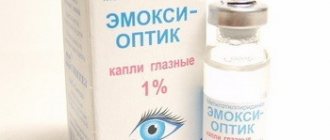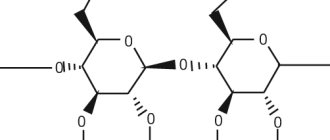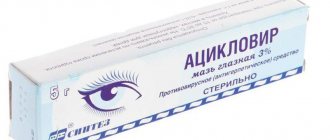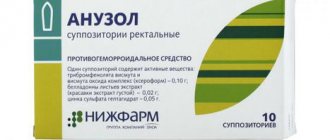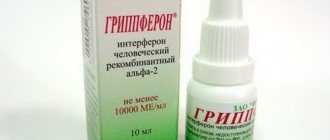Tsipromed eye drops are an ophthalmic drug with antibacterial activity. They are used to treat pathological conditions, the development of which is caused by the activity of bacteria sensitive to the active substance of the drug. The drug is prescribed to adults and children over 1 year of age. It is contraindicated in pregnant and breastfeeding women.
Pharmacological group
The drug represents a pharmacological group of drugs used in ophthalmology and having an antimicrobial effect. The main active component of the drug is ciprofloxacin, which belongs to the fluoroquinolones. It suppresses the functional activity of the bacterial DNA gyrase enzyme, as a result of which the replication (doubling) of deoxyribonucleic acid is disrupted and cell death occurs. The medicine has a bactericidal effect (causes the death of bacteria) against bacteria that are in the process of active division or at rest. The spectrum of activity of ciprofloxacin includes gram-negative and gram-positive microorganisms, which include staphylococci, streptococci, intestinal, Pseudomonas aeruginosa, Klebsiella, Proteus, Moraxella, Pseudomonas, Campylobacter, Citrobacter, Salmonella, Shigella, Corynebacterium, Listeria, Neisseria, Vibrio, Legionella.
After instillation of eye drops, ciprofloxacin penetrates well into the tissues and anterior chamber of the eye, where it has a therapeutic effect within 6 hours. It is partially absorbed into the blood, metabolized in the body and excreted in the urine.
Tsipromed or Dexamethasone
Dexamethasone
The drugs are not analogues of each other. Tsipromed is a drug from the fluoroquinolone group with the active ingredient Ciprofloxacin. Dexamethasone is a glucocorticosteroid for topical use in ophthalmology. Active ingredient: Dexamethasone. Tsipromed is indicated from 1 year of age. Dexamethasone can be prescribed to children from 6 years of age. The drug is indicated for the following diseases:
- conjunctivitis (non-purulent and allergic);
- keratitis;
- keratoconjunctivitis (without damage to the epithelium);
- blepharitis;
- scleritis;
- episcleritis;
- chorioretinitis;
- uveitis;
- blepharoconjunctivitis;
- optic neuritis;
- sympathetic ophthalmia;
- prevention and treatment of inflammation after surgery and trauma;
- restoration of corneal transparency and reduction of neovascularization after keratitis and burns.
More often, doctors prescribe this combination for the treatment of chalazion. Both drugs are prescribed by a doctor!
Dexamethasone is cheaper in cost than Tsipromed.
Indications for use
The drug is used for etiotropic therapy of infectious processes localized in the structures of the eye. It is aimed at destroying bacteria sensitive to ciprofloxacin.
for adults
There are several basic medical indications, the presence of which is the basis for prescribing a medication:
- Conjunctivitis with an acute or subacute course.
- Anterior uveitis.
- Dacryocystitis.
- Keratitis.
- Blepharitis and other infectious and inflammatory processes affecting the eyelids.
- Prevention of infectious complications after damage to the integrity of eye tissue as a result of injuries or after invasive interventions or surgical operations.
for children
The drug can be prescribed to children over 1 year of age for the same medical reasons.
for pregnant women and during lactation
The drug is contraindicated for use.
Which is better: Tsipromed or Otipax
Otipax.
Photo: vladivostok.apteki.me The drugs are not analogues of each other. Tsipromed is an antimicrobial drug of the fluoroquinolone group (active ingredient: Ciprofloxacin). Otipax is a combined drug that has anti-inflammatory, local anesthetic and analgesic effects. Active ingredients: Phenazone and Lidocaine hydrochloride. Release form: ear drops. Used for local symptomatic treatment and pain relief in adults and children (including newborns) for: otitis media in the acute period at the time of inflammation; otitis, as a complication after the flu; barotraumatic otitis. Both drugs are used in pediatrics: Tsipromed from 1 year, Otipax can be prescribed to newborns.
The country of origin of Otipax is France. Tsipromed is produced in India. Otipax is more expensive than Tsipromed.
Contraindications
There are several medical contraindications, the presence of which excludes the use of the drug, these include:
- Children's age less than 1 year.
- Pregnancy at any stage.
- Breastfeeding period.
- Individual intolerance to ciprofloxacin, other drugs from the fluoroquinolone group or auxiliary components of the drug.
Applications and dosages
Eye drops are instilled into the lower conjunctival sac. To do this, the head is tilted back, the lower eyelid is pulled back with a finger, and the instillation procedure is carried out with the other hand using a dropper bottle. It is important not to touch the tip of the dropper bottle to the surface of the eye, as this can cause mechanical damage or infection of the tissue.
for adults
The average recommended dose is 1-2 drops of ophthalmic solution. The frequency of installation depends on medical indications:
- Keratitis – 1 drop 6 times a day, the course of treatment depends on the speed of disappearance of signs of the infectious process, it varies from 2 to 4 weeks.
- Anterior uveitis – 1 drop 8-12 times a day, the course of treatment is determined by the attending physician.
- Prevention of infectious complications after eye injuries - 1 drop 4-8 times a day for 2 weeks.
- Acute bacterial conjunctivitis, simple, scaly, ulcerative blepharitis - 1-2 drops 4-8 times a day for a period of time from 5 to 14 days.
- Damage to the cornea with Pseudomonas aeruginosa - 1-2 drops up to 8-12 times a day for 2-3 weeks.
- Canaliculitis, acute dacryocystitis - the frequency of instillation varies from 6 to 12 times a day, which depends on the severity and duration of the infectious process.
- Prevention of inflammatory complications after surgical interventions on the structures of the eye, which were performed with opening of the eyeball - 1 drop 4-6 times a day for a period of time from 5 days to 1 month.
for children
The average recommended dose and regimen of the drug in pediatric practice do not differ significantly from adults.
for pregnant women and during lactation
No medication is used.
Side effects
After starting to use the medication, negative reactions from the organ of vision may develop. They include a burning sensation, irritation, redness (hyperemia) of the conjunctiva, injection of scleral vessels, swelling of the eyelids, decreased visual acuity, the appearance of a white insoluble crystalline precipitate in patients with ulcerative changes in the cornea, keratopathy, keratitis, an unpleasant taste in the mouth, which may appear immediately after instillation of an ophthalmic solution, the appearance of spots on the surface of the cornea, the development of superinfection. The occurrence of negative reactions is grounds for discontinuation of the drug and subsequent consultation with a medical specialist.
special instructions
Before starting to use the medicine, it is important to pay attention to the following several precautions:
- The drug contains an auxiliary compound, the preservative benzalkonium chloride, which has a negative effect on the condition of contact lenses. Before instillation of the ophthalmic solution, they should be removed; reinstallation is allowed no earlier than after 15 minutes. In general, it is recommended to wear contact lenses during the course of treatment.
- The procedure for installing the ophthalmic solution should be carried out with clean hands.
- It is important not to touch the tip of the dropper bottle to surrounding objects and the surface of the eye, as this increases the risk of infectious complications and superinfection.
- The active component and auxiliary compounds do not affect the functional activity of the structures of the central nervous system.
- Immediately after instillation of the ophthalmic solution, temporary blurred vision is possible, so it is recommended to refrain from performing potentially dangerous work (driving a car) for 15 minutes.
Tsipromed or Sulfacyl sodium
Sulfacyl sodium.
Photo: google.com Both drugs are not analogues of each other. Cipromed is an antimicrobial drug containing the active ingredient Ciprofloxacin. Sulfacyl sodium or the same Albucid is an antimicrobial drug of the sulfonamide group. Active ingredient: sodium sulfacetamide monohydrate (in terms of sodium sulfacetamide). The drug is indicated for the following processes:
- purulent corneal ulcers;
- conjunctivitis;
- blepharitis;
- gonorrheal eye diseases in newborns and adults;
- prevention of blenorrhea in newborns.
Sulfacyl sodium is cheaper in cost than Tsipromed.
Overdose
If a large amount of ophthalmic solution gets into your eyes, rinse them with plenty of water. In case of accidental ingestion of eye drops, specific symptoms do not develop. Nausea, periodic vomiting, headaches of varying severity, anxiety, and fainting may occur. Treatment involves general recommendations, including gastric and intestinal lavage, administration of intestinal sorbents, as well as symptomatic therapy.
Analogs
Alox
A structural analogue of the drug, which is produced in the dosage form of eye drops and contains ciprofloxacin. It has an antimicrobial effect and is used for etiotropic therapy of infectious processes in eye structures, aimed at destroying pathogens. The medicine is prescribed to adults. There is no experience of use in pediatric practice. Use is not recommended for pregnant and breastfeeding women.
Phloximed
Eye drops, the main active component of which is the antimicrobial agent ciprofloxacin, a representative of fluoroquinolones. The drug is prescribed to children over 1 year of age and adults. It is contraindicated during pregnancy, as well as during breastfeeding.
Ciloxane
The drug, which is available in the dosage form of eye drops, contains ciprofloxacin and has an antimicrobial effect against a large number of bacterial pathogens. The drug is prescribed to adults and adolescents over 12 years of age for the treatment of infectious pathologies caused by sensitive pathogens. The use of the medication is not recommended for pregnant and breastfeeding women.
Which is better: Tsipromed or Tobrex
Tobrex.
Photo: rigla.ru Both drugs are not analogues of each other. Tsipromed is a fluoroquinolone with the active substance – Ciprofloxacin. Available in the form of eye and ear drops. Tobrex is an antibiotic of the aminoglycoside group. Active ingredient: Tobramycin. Release form: eye drops. The drug is indicated for the following diseases:
- infections of the eye and its appendages (blepharitis; conjunctivitis; keratoconjunctivitis; blepharoconjunctivitis; keratitis; iridocyclitis);
- prevention of postoperative infections.
The medications are prescribed by the doctor.
The country of origin of Tsipromed is India. Tobrex is produced in Spain. Tobrex is more expensive than Tsipromed. Tobrex price from 168 rub.

